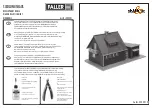
EN
11
Consult local laws and ordinances before choosing a fl ying location.
Range Check your Radio System
Before you fl y, range check the radio system. Refer to your specifi c transmitter
instruction manual for range test information.
Oscillation
Once the AS3X system is active (after advancing the throttle for the fi rst time),
you will normally see the control surfaces react to aircraft movement. In some
fl ight conditions you may see oscillation (the aircraft rocks back and forth on one
axis due to overcontrol). If oscillation occurs, refer to the Troubleshooting Guide
for more information.
Takeoff
Place the aircraft facing into the wind. Set your transmitter in low rate and use
your fl aps switch to drop the fl aps to takeoff or “half position”. Gradually increase
the throttle to ¾ and steer with the rudder.
Flaps make takeoffs shorter
. As the
tail comes off the ground, pull back gently on the elevator. When airborne, fl ip
your gear switch to raise your landing gear. Climb to a comfortable altitude and
then fl ip your fl aps switch to level the fl aps.
Flying
For your fi rst fl ights with the recommended battery pack (EFLB22003S30), set
your transmitter timer or a stopwatch to 5 minutes. After fi ve minutes, land the
aircraft. Adjust your timer for longer or shorter fl ights once you have fl own the
model. If at any time the motor pulses, land the aircraft immediately to recharge
the fl ight battery. See the Low Voltage Cutoff (LVC) section for more details on
maximizing battery health and run time.
Landing
Land the aircraft into the wind. Use high rate Elevator for landings. Use a small
amount of throttle for the entire descent. Lower the throttle to ¼ and fl ip your
fl aps switch to deploy the fl aps to the landing or “full down position”.
Flaps will
make the landing approach steeper and slower, and allow for a smoother
landing.
Flip your gear switch to lower your landing gear. This will slow the
aircraft further.
Keep the throttle on until the aircraft is ready to fl are. During fl are, keep the
wings level and the aircraft pointed into the wind. Gently lower the throttle while
pulling back on the elevator to bring the aircraft down on its wheels.
If landing on grass, it is best to hold full up elevator after touchdown and when
taxiing to prevent nosing over.
Once on the ground, avoid sharp turns until the plane has slowed enough to
prevent scraping the wingtips.
WARNING:
Always decrease throttle at propeller strike.
NOTICE:
If a crash is imminent, reduce the throttle and trim fully. Failure to do so
could result in extra damage to the airframe, as well as damage to the ESC and
motor.
NOTICE:
After any impact, always ensure the receiver is secure in the fuselage.
If you replace the receiver, install the new receiver in the same orientation as the
original receiver or damage may result.
NOTICE:
Crash damage is not covered under warranty.
NOTICE:
When you are fi nished fl ying, never leave the aircraft in direct sunlight
or in a hot, enclosed area such as a car. Doing so can damage the aircraft.
Low Voltage Cutoff (LVC)
When a Li-Po battery is discharged below 3V per cell, it will not hold a charge.
The ESC protects the fl ight battery from over-discharge using Low Voltage
Cutoff (LVC). Before the battery charge decreases too much, LVC removes
power supplied to the motor. Power to the motor pulses, showing that some
battery power is reserved for fl ight control and safe landing.
Disconnect and remove the Li-Po battery from the aircraft after use to prevent
trickle discharge. Charge your Li-Po battery to about half capacity before storage.
During storage, make sure the battery charge does not fall below 3V
per cell. LVC does not prevent the battery from over-discharge during storage.
NOTICE:
Repeated fl ying to LVC will damage the battery.
Tip
: Monitor your aircraft battery’s voltage before and after fl ying by using a
Li-Po Cell Voltage Checker (EFLA111, sold separately).
Repairs
Thanks to the EPO foam material in this aircraft, repairs to the foam can be made
using virtually any adhesive (hot glue, regular CA, epoxy, etc). When parts are
not repairable, see the Replacement Parts List for ordering by item number. For
a listing of all replacement and optional parts, refer to the list at the end of this
manual.
NOTICE:
Use of CA accelerant on your aircraft can damage paint. DO NOT handle
the aircraft until accelerant fully dries.
During your fi rst fl ight, trim the aircraft for level fl ight at 3/4 throttle with
fl aps and gear up. Make small trim adjustments with your transmitter’s trim
switches to straighten the aircraft’s fl ight path.
After adjusting trim do not touch the control sticks for 3 seconds. This allows
the receiver to learn the correct settings to optimize AS3X performance.
Failure to do so could affect fl ight performance.
3 Seconds
Center of Gravity (CG)
In Flight Trimming
Flying Tips and Repairs
The CG location is measured from the leading edge of the wing at the root.
This CG location has been determined with the recommended Li-Po battery
(EFLB22003S30) installed to the front edge of the battery tray.
Tip: Measure the CG with the aircraft inverted.
NOTICE:
Install the battery but do not arm the ESC while checking the CG.
Personal injury may result.
50mm - 44mm
back from leading edge at
the root with gear down




































